|
These photos were taken at the SAC Museum in Omaha, NE.
Phillip Juvet
|
Click on
images below to see larger images
|
|
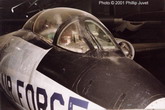 |
|
Walking
clockwise around nose, windscreen, pitot tube, radome and antenna are
inspected.
|
|
|
|

|
|
Walking
clockwise around nose, windscreen, pitot tube, radome and antenna are
inspected. |
|
|
 |
| Walking
clockwise around nose, windscreen, pitot tube, radome and antenna are
inspected. |
|
|
 |
| wing fuselage join |
|
|
|
|
Click on
images below to see larger images
|
|
|
|
Click on
images below to see larger images
|
|
|
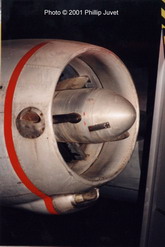 
|
|
#2
engine intake is checked for loose fasteners. Compressor blade can be
reached to rotate. Starter exhaust duct is checked for secure fit. An 8
lb. gunpowder charge fires the starter. This starting procedure
sometimes attracted the attention of unaware Crash and Rescue crews at
remote
bases. The scoop under the engine intake directs
air to (2) AC and (1) DC generators. Much of the AC power is for
electronic countermeasure equipment. EB-571s had cannons and guns
removed. for ECM operations. Check gun bay doors for security, fuel vent
for security, underwing surface for fuel leakage. Each wing has three
fuel cells. Fuel gravity feeds from outboard to inboard, then is
transferred to fuselage tank. Dive finger spoilers extend from top and
bottom wing surfaces when speed brake is deployed.
|
|
|
|

|
|
Photo
11 |
|
|
|
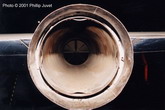
|
|
Tailpipes
and tail cone aspirators are checked for cracks. There is side
movement on the tailpipes which creates a distinctive WOW-WOW sound at
55% throttle. The sound is eerie when engine Rpm's are slightly out of
sync.
|
|
|
|
|
Click on
images below to see larger images
|
|
|
|
Click on
images below to see larger images
|
|
|
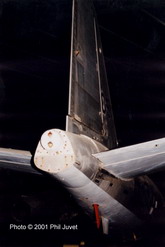
|
|
tip
of tail
|
|
|
|
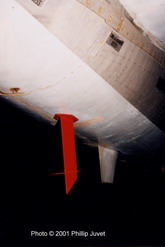
|
|
Sft
fuel dump
|
|
|
|
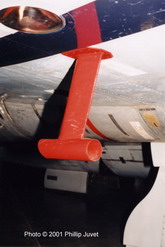
|
|
wing
fuel dump |
|
|
|
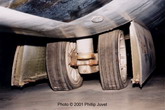
|
|
Nose
gear tires are checked for wear and inflation. Nose gear
actuator and emergency down accumulator gauge is checked for proper
servicing. Inspect oleo strut for recommended height and leakage. There
is no nose wheel steering actuator. Strut is a self-centering cam style
oleo. Aircraft is steered with brake and opposing engine thrust.
Inspecting wheel well is not fun during foul weather due to the plane1s
low nose posture. Forward right fuselage has 2 compartments. upper is
for LOX servicing
and lower is an avionics bay and also contains an hydraulic accumulator
for the bomb bay door.
Landing light is underwing forward of wheel well. Wheel well is
inspected for leakage at door actuators, struts for proper height..
Emergency gear down accumulator gauge checked for proper servicing.
Check
wing fuel boost pump for leakage. Engine fire extinguishing system for
service. |
|
|
|
|
Click on
images below to see larger images
|
|
|
|
|
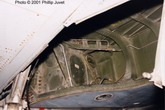
|
|
main
gear well
|
|
|
|
|
Click on
images below to see larger images
|
|
|
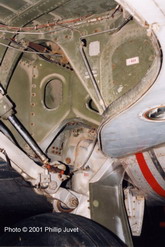
|
|
main
gear well
|
|
|
|
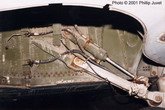
|
|
main
gear well
|
|
|
|
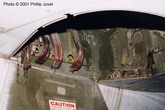
|
|
main
gear well
|
|
|
|
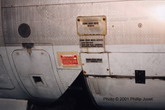
|
|
Preflight
inspection started at the Battery Access compartment,
where the Aircraft Maintenance Forms where kept. This compartment is
lower
left fuselage below rear cockpit. Inside is a 24v lead-acid battery that
slides out on a track for servicing. When the aircraft is parked, the
battery is disconnected to prevent drain from a system that I can not
recall. A pump handle is stowed in this compartment to raise and
lower the hydraulically operated canopy while aircraft is parked. |
|
|
|
|
Click on
images below to see larger images
|
|
 |
|
Inspect
speed brakes for hydraulic leakage. Aft fuselage has a drop down hinged
access bay. Elevator and rudder
control rods for security. EB-57E as a power rudder for earlier
tow-target operations. Several ECM boxes are located in this section
also. Tail surfaces are out of reach, visually inspect control
surfaces,
antenna and navigation lights. Check fuel dump manifold for
security.
Anti-collision rotating beacon lights are on the top
and bottom of the
fuselage. Left side walk-around is a repeat of the right side.
Access to the bombay is usually from the left side. Fuel boost pumps (4)
are located for and aft for fuselage fuel transfer. Inspect for leakage.
The #2 engine is started first so that starter exhaust is ducted away
from open cockpit. When hydraulic pressure is achieved canopy is lowered
and the #1 engine is started.
|
|
|
|
|